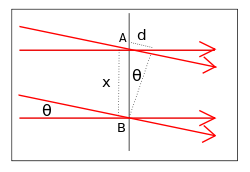In physics, interference is a phenomenon in which two waves superpose to form a resultant wave of greater, lower, or the same amplitude. Constructive and destructive interference result from the interaction of waves that are correlated or coherent with each other, either because they come from the same source or because they have the same or nearly the same frequency. Interference effects can be observed with all types of waves, for example, light, radio, acoustic, surface water waves, gravity waves, or matter waves. The resulting images or graphs are called interferograms.
Mechanisms[edit]
The principle of superposition of waves states that when two or more propagating waves of the same type are incident on the same point, the resultant amplitude at that point is equal to the vector sum of the amplitudes of the individual waves.[1] If a crest of a wave meets a crest of another wave of the same frequency at the same point, then the amplitude is the sum of the individual amplitudes—this is constructive interference. If a crest of one wave meets a trough of another wave, then the amplitude is equal to the difference in the individual amplitudes—this is known as destructive interference.
Constructive interference occurs when the phase difference between the waves is an even multiple of π (180°), whereas destructive interference occurs when the difference is an odd multiple of π. If the difference between the phases is intermediate between these two extremes, then the magnitude of the displacement of the summed waves lies between the minimum and maximum values.
Consider, for example, what happens when two identical stones are dropped into a still pool of water at different locations. Each stone generates a circular wave propagating outwards from the point where the stone was dropped. When the two waves overlap, the net displacement at a particular point is the sum of the displacements of the individual waves. At some points, these will be in phase, and will produce a maximum displacement. In other places, the waves will be in anti-phase, and there will be no net displacement at these points. Thus, parts of the surface will be stationary—these are seen in the figure above and to the right as stationary blue-green lines radiating from the centre.
Interference of light is a common phenomenon that can be explained classically by the superposition of waves, however a deeper understanding of light interference requires knowledge of wave-particle duality of light which is due to quantum mechanics. Prime examples of light interference are the famous double-slit experiment, laser speckle, anti-reflective coatings and interferometers. Traditionally the classical wave model is taught as a basis for understanding optical interference, based on the Huygens–Fresnel principle.
Derivation[edit]
The above can be demonstrated in one dimension by deriving the formula for the sum of two waves. The equation for the amplitude of a sinusoidal wave traveling to the right along the x-axis is
where is the peak amplitude, is the wavenumber and is the angular frequency of the wave. Suppose a second wave of the same frequency and amplitude but with a different phase is also traveling to the right
where is the phase difference between the waves in radians. The two waves will superpose and add: the sum of the two waves is
Using the trigonometric identity for the sum of two cosines: this can be written
This represents a wave at the original frequency, traveling to the right like its components, whose amplitude is proportional to the cosine of .
- Constructive interference: If the phase difference is an even multiple of π: then , so the sum of the two waves is a wave with twice the amplitude
- Destructive interference: If the phase difference is an odd multiple of π: then , so the sum of the two waves is zero
Between two plane waves[edit]
A simple form of interference pattern is obtained if two plane waves of the same frequency intersect at an angle. Interference is essentially an energy redistribution process. The energy which is lost at the destructive interference is regained at the constructive interference. One wave is travelling horizontally, and the other is travelling downwards at an angle θ to the first wave. Assuming that the two waves are in phase at the point B, then the relative phase changes along the x-axis. The phase difference at the point A is given by
It can be seen that the two waves are in phase when
and are half a cycle out of phase when
Constructive interference occurs when the waves are in phase, and destructive interference when they are half a cycle out of phase. Thus, an interference fringe pattern is produced, where the separation of the maxima is
and df is known as the fringe spacing. The fringe spacing increases with increase in wavelength, and with decreasing angle θ.
The fringes are observed wherever the two waves overlap and the fringe spacing is uniform throughout.
Between two spherical waves[edit]
A point source produces a spherical wave. If the light from two point sources overlaps, the interference pattern maps out the way in which the phase difference between the two waves varies in space. This depends on the wavelength and on the separation of the point sources. The figure to the right shows interference between two spherical waves. The wavelength increases from top to bottom, and the distance between the sources increases from left to right.
When the plane of observation is far enough away, the fringe pattern will be a series of almost straight lines, since the waves will then be almost planar.
Multiple beams[edit]
Interference occurs when several waves are added together provided that the phase differences between them remain constant over the observation time.
It is sometimes desirable for several waves of the same frequency and amplitude to sum to zero (that is, interfere destructively, cancel). This is the principle behind, for example, 3-phase power and the diffraction grating. In both of these cases, the result is achieved by uniform spacing of the phases.
It is easy to see that a set of waves will cancel if they have the same amplitude and their phases are spaced equally in angle. Using phasors, each wave can be represented as for waves from to , where
To show that
one merely assumes the converse, then multiplies both sides by
The Fabry–Pérot interferometer uses interference between multiple reflections.
A diffraction grating can be considered to be a multiple-beam interferometer; since the peaks which it produces are generated by interference between the light transmitted by each of the elements in the grating; see interference vs. diffraction for further discussion.
Optical interference[edit]
Because the frequency of light waves (~1014 Hz) is too high to be detected by currently available detectors, it is possible to observe only the intensity of an optical interference pattern. The intensity of the light at a given point is proportional to the square of the average amplitude of the wave. This can be expressed mathematically as follows. The displacement of the two waves at a point r is:
where A represents the magnitude of the displacement, φ represents the phase and ω represents the angular frequency.
The displacement of the summed waves is
The intensity of the light at r is given by
This can be expressed in terms of the intensities of the individual waves as
Thus, the interference pattern maps out the difference in phase between the two waves, with maxima occurring when the phase difference is a multiple of 2π. If the two beams are of equal intensity, the maxima are four times as bright as the individual beams, and the minima have zero intensity.
The two waves must have the same polarization to give rise to interference fringes since it is not possible for waves of different polarizations to cancel one another out or add together. Instead, when waves of different polarization are added together, they give rise to a wave of a different polarization state.
https://en.wikipedia.org/wiki/Wave_interference











![{\displaystyle W_{1}+W_{2}=A[\cos(kx-\omega t)+\cos(kx-\omega t+\varphi )].}](https://wikimedia.org/api/rest_v1/media/math/render/svg/bdda8db2a7505764bd6168a596b91e4bcb8b57b6)
























![U_1 (\mathbf r,t) = A_1(\mathbf r) e^{i [\varphi_1 (\mathbf r) - \omega t]}](https://wikimedia.org/api/rest_v1/media/math/render/svg/98aacb5c083f2a9e622b1f61dbdc7e2e5d215f6a)
![U_2 (\mathbf r,t) = A_2(\mathbf r) e^{i [\varphi_2 (\mathbf r) - \omega t]}](https://wikimedia.org/api/rest_v1/media/math/render/svg/770aa815a1ce0cc0fb915490fbede1bdee62c3dc)
![{\displaystyle U(\mathbf {r} ,t)=A_{1}(\mathbf {r} )e^{i[\varphi _{1}(\mathbf {r} )-\omega t]}+A_{2}(\mathbf {r} )e^{i[\varphi _{2}(\mathbf {r} )-\omega t]}.}](https://wikimedia.org/api/rest_v1/media/math/render/svg/b542dc54af62dc120ead82e5091754941451a393)
![{\displaystyle I(\mathbf {r} )=\int U(\mathbf {r} ,t)U^{*}(\mathbf {r} ,t)\,dt\propto A_{1}^{2}(\mathbf {r} )+A_{2}^{2}(\mathbf {r} )+2A_{1}(\mathbf {r} )A_{2}(\mathbf {r} )\cos[\varphi _{1}(\mathbf {r} )-\varphi _{2}(\mathbf {r} )].}](https://wikimedia.org/api/rest_v1/media/math/render/svg/b7d47a3560c51fa16a533d69ee2523a20b9a159c)
![{\displaystyle I(\mathbf {r} )=I_{1}(\mathbf {r} )+I_{2}(\mathbf {r} )+2{\sqrt {I_{1}(\mathbf {r} )I_{2}(\mathbf {r} )}}\cos[\varphi _{1}(\mathbf {r} )-\varphi _{2}(\mathbf {r} )].}](https://wikimedia.org/api/rest_v1/media/math/render/svg/7f41265d6a2a8696fb6e681c5c64043ad1cfd644)
No comments:
Post a Comment